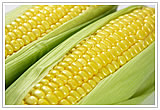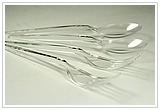 |
| |
U-Molding ‘s PLA Disposable Tableware with very competitive prices.
1. 90% Nature Works PLA above / 100% Nature PLA
2. Accord with Greenly protection demands
3. After crystallize can be heat-resistant
4. Heat-resistant 115 ºC above.
Natural / Nontoxic / Renewable / Recyclable |
  |
Professional Poly Lactic Acid injection molded Products Manufacture
Environmental Production
About PLA (Green Plastic)
PLA (Poly Lactic Acid) is a biodegradable, thermoplastic polymer derived from renewable resources.
It is a resin derived entirely from natural corn materials.
- Environmentally sustainable
- 100% compostable
- PLA is approved by America FDA
- PLA is 100% renewable through annual corn harvests and fully compostable in municipal and industrial facilities.
Manufacture process of PLA (Comes from the nature)
Polylactide (PLA), is produced from natural resources such as starch and cellulose. We can easily observed from plants, such as corn, potato, rice, etc. Because of this character, PLA products can be easily decomposed into natural environment.It not only has no pollution, but improve the soil nutrient.

Decomposition process of PLA (Decomposed into H2O and CO2)
PLA can be decomposed into water and carbon dioxide in the compost environment of the nature. It not only has no pollution, but improve the soil nutrient.

Most of Biodegradable materials, which result in white smoke due to the sources of plant fiber and glucose ( Certainly, the smell of the smoke just likes burning paper and sugar.), are different from plastics produces in many ways. Unlike biodegradable materials, burning plastics releases black smoke and stench. And it is easy to distinguish the odor between the smoke of burned PLA and other plastics. So, combustion is a common way to distinguish the two kinds of materials.
The advantages of PLA
- 100% biodegradable and compost:
PLA was abandoned in the natural world can be broken down into lactic acid in the final for the hydrolysis of carbon dioxide and water. Plants through photosynthesis, carbon dioxide and water can be turned into starch, in the cycle of nature, the formation of the ecological balance.
- energy reduction, environmental protection:
polylactic acid in the production process, which uses energy consumption was significantly lower than that of the PP, PET, PA, and other petroleum-based resin, which is equivalent to only 20-50%.
- superior physical properties:
polylactic acid in all the biodegradable polymer in the highest melting point and crystallinity, transparency applies to blow, thermoplastic, such as drawing a variety of processing methods, Machinable into polylactic acid film, poly Fiber, such as lactic acid.
- adequate sources of raw materials:
the production of polylactic acid as the raw material of corn, potato, and other renewable resources, without the use of oil, timber, and other valuable natural resources, the increasing depletion of oil and natural resources will play a very protective effect.
Comparison Of Various Disposable Tableware In Market
Comparing the affection to environment and human body caused by disposable tableware, PE tableware, plastic tableware, and the kind made of unhusked rice.
| Influences on environment |
Merchandise traits |
Polyfoam
|
Need to be collected to authorized dump. It generates Dioxin and never decomposes under ground. |
Under high temperature would thaw out carcinogenic substances and cause serious harm to human health. |
PE
Laminating paper tableware |
- To collect its raw materials, wood pulp, excessive deforest become inevitable that results to critical environment problem.
- Although this food-container kind is partially made of paper, but its PE laminating surface still can not decompose naturally.
|
Using paste method causes leaking while we use this kind as containers. The PE coating cannot endure heat. It has dissolution anxiety. Low hardness makes it hard to hold. |
| Plastic Tableware |
Plastic tableware relies significantly on well-organized recycling system to handle such kind’s discarding. Those recycled objects only can be re-manufactured into PP products. However, the PP products still exists pollution problem. |
Low heat endurance, it might dissolve harmful substances when it encounters high temperature. |
| Just-Only Pulp Mode tableware |
The materials are 100% botanic fiber, which has no recycle problem and can decompose into fertilizer under ground in 3 to 6 months. Excellent temper, barely occurs distortion. |
- Conventional Oven proof to 150℃ over 20 Min.
- Microwave safe, to 250℃ for 1 hr.
- Steamer safe, it won’t distortion under high humidity conditions.
- Directly cooking sate.
- While placed in the soil, it’s biodegradable within three months.
- Surface ventilation may prolong the expiration and the taste of food.
- High plasticily to be made to any shape.
- Using ogriculture waste as its material, it’s abundant supply.
|
| Rice materials tableware |
Mainly made of rice husk and straw. The container does not melt because of professional adhesive adding and surface treating process. |
Rice itself might retain toxic chemicals due to massive spray in fields. It is also heavy and crumbly while moving. It’s non-greaseproof, non-waterproof and dark oppearance. |
|
 |
|
